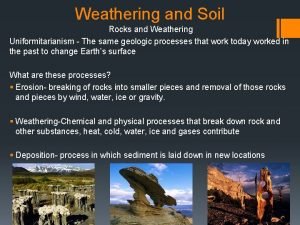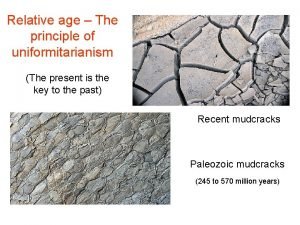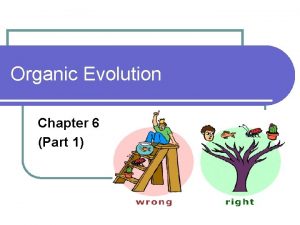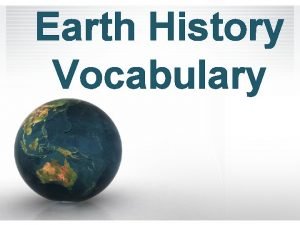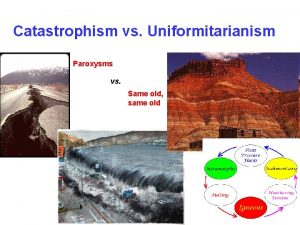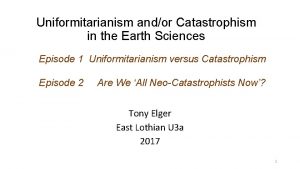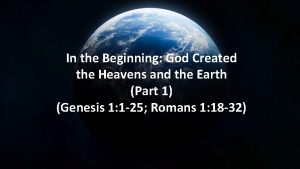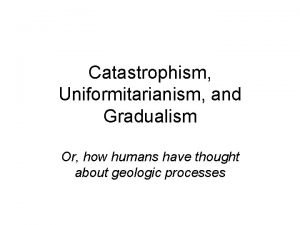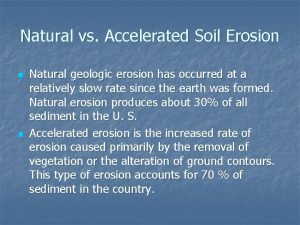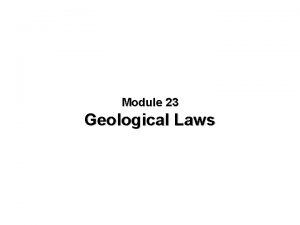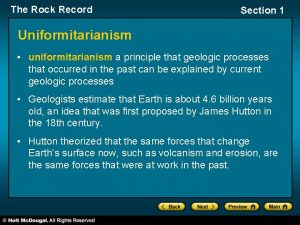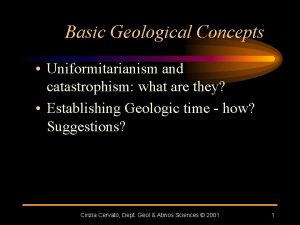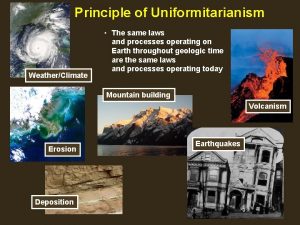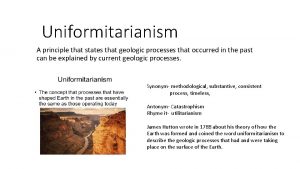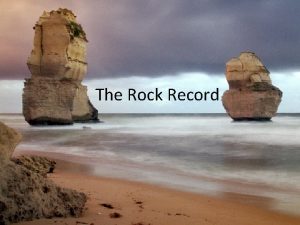Chapter 17 1 Principle of Uniformitarianism Current geological













- Slides: 13

Chapter 17. 1 Principle of Uniformitarianism “Current geological processes are the same as those at work in the past” James Hutton (1726 -1797) Father of modern geology Men of Rock – Deep Time (Stop at 39 min) http: //www. youtube. com/watch? v=bake. XEdl. XXc Hutton’s Uncomformity (BBC 3: 48) http: //www. youtube. com/watch? v=l. Mf. PSdrrj. ZI James Hutton- The Discovery of deep time 6: 17 http: //www. youtube. com/watch? v=2 yb. BPqw. WF 4 Q Sir Charles Lyell (1797 -1875) Author “Principles of Geology” Foremost geologist of his day

Determining Relative Age (What is older, or younger. . . not how old chronologically) 1. Law of Superposition – layers of sedimentary rock are older than the layers above it, and younger than the layers below it.

2. Unconformities Movements of the earth lift up rock layers. Layers are exposed to erosion. Sediments are deposited, forming new rock layers Stratified rock rests upon unstratified rock Stratified rock rests upon tilted stratified rock Stratified rock rests upon stratified rock, with a large time gap

3. Crosscutting Relationships – a fault or an intrusion is always younger than the rock layers it cuts through A – oldest; deepest layer B – next oldest, layer above C – next oldest, layer above D – dike cuts through existing layers E – crack filled through existing layers; youngest Turn & Talk Identify the oldest to the youngest layers

17. 2 Determining Absolute Age (How old? . . . 100, 000 yrs old? A million years old? ) 1. Rates of Erosion and Deposition Erosion rates are accurate, only w/in the last 10 -20 thousand years. Over long periods of time, erosion rates can vary greatly. ~30 cm of sedimentary rock is deposited every 1000 yrs. But, floods can deposit many meters of sediment in a single day

2. Varve Count Like counting tree rings, Varve counts are based on annual sedimentary deposits Layers (varves) of alternating light and dark colored bands Light bands – course particles Dark bands – fine particles May be inconsistent. Why?

3. Radioactive Decay More accurate method for finding the absolute age of rocks Unstable isotopes lose particles and energy at a constant rate. This rate of change is measureable and is not affected by external factors U-238 emits 2+ & 2 N. . . mass now 234 element now 90 (Thorium) Review from Chapter 8: The atomic number = # protons. The atomic mass = the sum of protons + neutrons U-238 has 92 protons & 146 neutrons (mass = 238) This cycle continues until a stable form (Pb-206) is reached. SEE TABLE p. 239

3. Radioactive Decay (con’t) Half-Life – time it takes for half the mass of a given element to decay into its daughter elements Uranium-238 has a very long half life (4. 5 billion years) • useful for rocks 10 million to 4. 5 billion years old Carbon-14 has a very short half life (5730 years) • useful for rocks between 100 to 30, 000 years • only used for organic materials (once living)

17. 3 The Fossil Record Fossils – remains or traces of animals or plants from a previous geologic time Paleontology – the study of fossils Fossils provide clues to past geologic events, climates, and evolution of species. Fossils are generally found in sedimentary rock. • Igneous rock forms from magma; remains burn up • Metamorphic rock forms from heat and pressure, destroying any fossils inside

Kinds of Fossils 1. Preservation of Organisms - Usually only the hard parts of organisms fossilize; in rare cases, the whole organism is preserved. . . a. Mummification - drying c. Tar Beds – large variety b. Amber – tree sap d. Freezing

2. Petrification – minerals in ground water replace the original organic material; slow process, often resulting in perfect replica Florissant fossil beds National Monument

3. Traces of Organisms – no part of the original tissue survives Trace fossils – example: footprints, burrows Coprolites Gastroliths Imprints Molds Casts

Interpreting the Fossil Record Index Fossils – fossils found exclusively in rock layers of a particular geologic age. Trilobites (245 -550 mya) & Ammonites (65 -200 mya) are good index fossils
 Uniformitarianism vs catastrophism
Uniformitarianism vs catastrophism Breaking down of rocks
Breaking down of rocks Unconformity
Unconformity Uniformitarianism examples
Uniformitarianism examples Whats uniformitarianism
Whats uniformitarianism Catastrophism theory
Catastrophism theory Uniformitarianism drawing
Uniformitarianism drawing Uniformitarianism
Uniformitarianism Uniformitarianism vs gradualism
Uniformitarianism vs gradualism Continental drift theory and plate tectonics theory
Continental drift theory and plate tectonics theory Roman architecture influence
Roman architecture influence Differentiate between geological and accelerated erosion
Differentiate between geological and accelerated erosion Principle of faunal succession
Principle of faunal succession J fred muir memorial scholarship in science
J fred muir memorial scholarship in science

